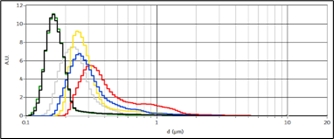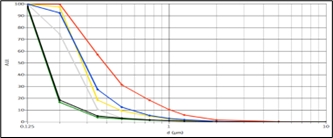[vc_row full_width_row=”true”][vc_column css=”.vc_custom_1469801256433{margin-top: -50px !important;}”][vc_column_text][maxmegamenu location=max_mega_menu_3][/vc_column_text][/vc_column][/vc_row][vc_row][vc_column][vc_column_text css_animation=”fadeInDown”]A broad collection of pigment, powder coatings, and ink products exist as particulate form in both the raw material and finished product. The particle size distribution determines their appearance, quality, functionality and processability, thus measuring the pigment particle size is as an excellent predictor of final product performance. Moreover, particle size of pigment particles in paint is a critical parameter that affects surface finish. As for example, cosmetic industry is always looking for the best mix between creativity and innovation and color pigments cover a fundamental role in this. To create metallic effects, white, interference, reflections, particles with adequate characteristics have to be selected. Classizer™ ONE is an enabling device supporting product formulation, thanks to its performances in charactering particle size distribution, composition, shape, best surfactant and the stability of pigments, inks, and cosmetics powders.[/vc_column_text][/vc_column][/vc_row][vc_row][vc_column][vc_message message_box_style=”solid-icon” message_box_color=”grey” icon_fontawesome=”fa fa-check-square” css_animation=”fadeInDown”] Market overview – Example of the printing ink market – Printing inks consist of pigments of the required color mixed with oil or varnish, majorly a black ink made from carbon blacks and thick linseed oil added. It is expected to reach 3,469.09 thousand metric tons by the end of this year and is projected to register a CAGR of over 2.5% during the forecast period.
Quality control and R&D – Ink and pigment manufacturers know that they must constantly monitor the characteristics of their products to ensure high quality output for their customers. In particular, they want to keep the ink stable over time without it suffering degradation in quality. An unstable ink over time can lead to the presence of impurities and aggregates. The needles of the print heads risk clogging in case of aggregation phenomena or insufficient grinding. An analysis of oversize and out of specification must be carried out constantly over time, to limit or avoid blockages. A clogged machine is a machine that does not produce and which leads to economic losses.
Classizer™ ONE added value – Some problems cannot be solved with traditional techniques. The patented technologies developed by EOS allow to monitor ink oversizes with an unprecedented level of detail. The large particles present in the mixture can be due either to inpurities, poorly ground powder, and to aggregation of smaller particles. The different cases can be distinguished because the optical particle properties are different. In the first case, the inpurities will have a different refractive index, in the second case the refractive index of the particles is compatible with the value expected for the bulk material, while in the latter case the solvent inclusions will lower the effective refractive index of the measured particles. This allows to monitor and distinguish the cases.[/vc_message][/vc_column][/vc_row][vc_row][vc_column width=”1/3″][vc_message message_box_style=”solid-icon” message_box_color=”blue” icon_type=”linecons” css_animation=”fadeInLeft” icon_linecons=”vc_li vc_li-bulb”]The mix of a pigment and an emulsion
A lot of ink, watercolour, and oil pigment formulations includes particles of different size distribution and different material composition. Formulations of pigments in cosmetics, paints, inks, coating, and other multiple sectors require the dispersion of different materials such as oil emulsions and ground pigments in a liquid. The analysis of the pigment particle populations and the identification of oil droplets individually suspended in the liquid require the ability to identify populations according to e.g., their respective optical properties. The SPES/SPES² patented technologies and Classizer™ family of particle analysers provide the adequate information as needed and suitable for the purpose to distinguish the different types and relative concentrations of the suspended materials.
 (in figure) An uncalibrated mixture of blue ultramarine and oil emulsion. Two populations are detected and may be analysed indipendently.
(in figure) An uncalibrated mixture of blue ultramarine and oil emulsion. Two populations are detected and may be analysed indipendently.
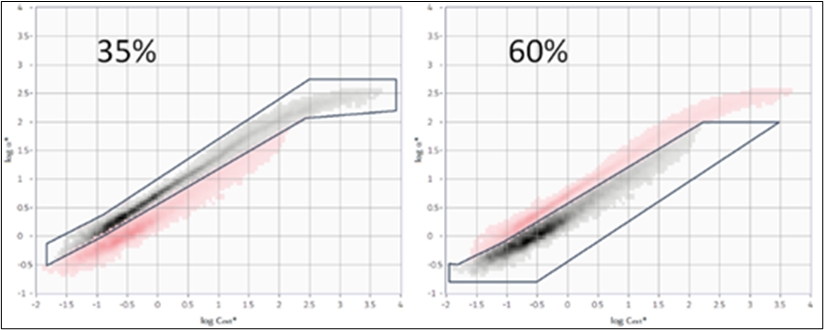 (in figure) Experimental estimation of the relative number of particles attributable to the individual components of the mixture of ultramarine pigment and the oil emulsions.[/vc_message][/vc_column][vc_column width=”1/3″][vc_message message_box_style=”solid-icon” message_box_color=”blue” icon_type=”linecons” css_animation=”fadeInLeft” icon_linecons=”vc_li vc_li-bulb”]The case of two inks mixed
(in figure) Experimental estimation of the relative number of particles attributable to the individual components of the mixture of ultramarine pigment and the oil emulsions.[/vc_message][/vc_column][vc_column width=”1/3″][vc_message message_box_style=”solid-icon” message_box_color=”blue” icon_type=”linecons” css_animation=”fadeInLeft” icon_linecons=”vc_li vc_li-bulb”]The case of two inks mixed
Inks are a liquid dispersion of pigments for writing or printing made by pigment particles in some liquid carrier. A number of additives are usually included to modify viscosity, drying, stability, or color characteristics. Particle size of the particles can affect the color strength, surface finish, and durability of the product. The particle size must be small enough that they do not block the nozzles of the printing mechanism. Through the study of the properties of the individual particles, the SPES/SPES² techniques classify the presence of particles having different characteristics in a same sample. Via EOS CLOUDS representation it is possible to select and analyze the individual particle populations in a mixture evaluating and monitoring the ratios between the numerical concentrations of the components of a mixture in a formulation.
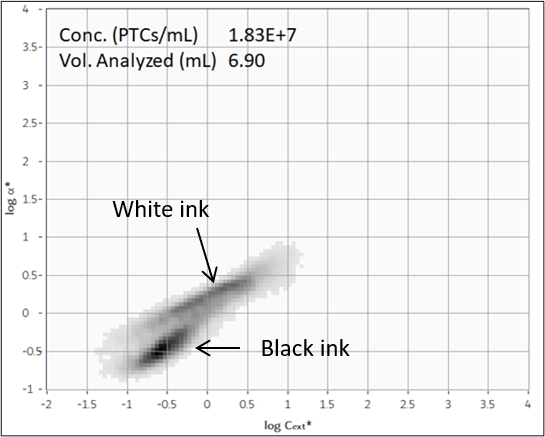 (in figure) A 50:50 mixture of white and black calligraphic inks. Two populations are detected and may be analysed indipendently.
(in figure) A 50:50 mixture of white and black calligraphic inks. Two populations are detected and may be analysed indipendently.
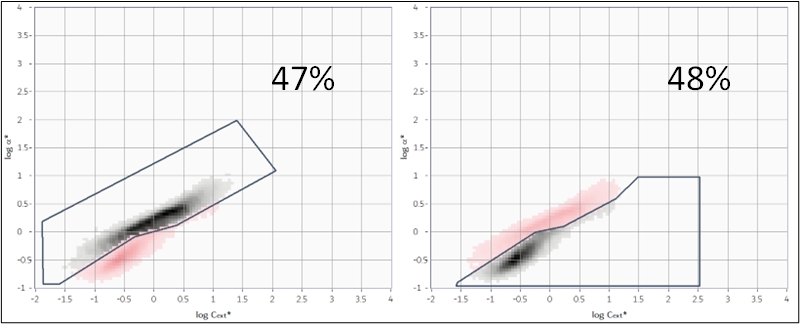 (in figure) Experimental estimation of the relative number of particles attributable to the individual components of the mixture of white and black calligraphic inks.[/vc_message][/vc_column][vc_column width=”1/3″][vc_message message_box_style=”solid-icon” message_box_color=”blue” icon_type=”linecons” css_animation=”fadeInLeft” icon_linecons=”vc_li vc_li-bulb”]Quantitative Analysis
(in figure) Experimental estimation of the relative number of particles attributable to the individual components of the mixture of white and black calligraphic inks.[/vc_message][/vc_column][vc_column width=”1/3″][vc_message message_box_style=”solid-icon” message_box_color=”blue” icon_type=”linecons” css_animation=”fadeInLeft” icon_linecons=”vc_li vc_li-bulb”]Quantitative Analysis
The capability of Classizer™ ONE and SPES/SPES² patented methods fit the need of a value-added application in the characterization of Inks, watercolours, and oil pigments. SPES/SPES² data provides physical and statistical information, as PSD and oversize. Each characteristic can be crucial to improve the knowledge and the quality of an formulate even with secondary populations and mixes.
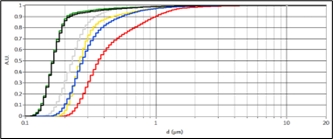 (in figure) Numerical and Cumulative PSDs of a set of watercolours.
(in figure) Numerical and Cumulative PSDs of a set of watercolours.
 (in figure) Oversize Analyses of a set of watercolours.[/vc_message][/vc_column][/vc_row][vc_row][/vc_row][vc_column][/vc_column][dt_button link=”https://www.eosinstruments.com/publications/” button_alignment=”center” animation=”fadeInUp” size=”big”]Discover more > EOS Application Note AN018 SPES Classification of Inks, Watercolours, and Pigments[/dt_button][vc_column_text]
(in figure) Oversize Analyses of a set of watercolours.[/vc_message][/vc_column][/vc_row][vc_row][/vc_row][vc_column][/vc_column][dt_button link=”https://www.eosinstruments.com/publications/” button_alignment=”center” animation=”fadeInUp” size=”big”]Discover more > EOS Application Note AN018 SPES Classification of Inks, Watercolours, and Pigments[/dt_button][vc_column_text]
I am text block. Click edit button to change this text. Lorem ipsum dolor sit amet, consectetur adipiscing elit. Ut elit tellus, luctus nec ullamcorper mattis, pulvinar dapibus leo.
[/vc_column_text]
